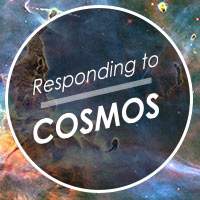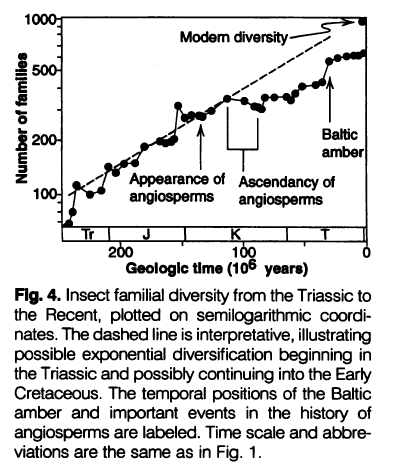 Faith & Science
Faith & Science
 News Media
News Media
 Physics, Earth & Space
Physics, Earth & Space
Cosmos Episode 6: Science as the New Sacred, and Failed Darwinian Predictions About Insects and Flowers

Cosmos episode 6 is ostensibly about the miniature reality of the atom. Once again, there are some spectacular animations explaining the nature of the atom, and how they interact to form chemical bonds. We are also treated to animations of semi-steampunk-style molecular machines, supposedly mimicking molecular machines in biology. Host Neil deGrasse Tyson has yet to dare tackle the question of how molecular machines might have evolved, but in this episode he did throw in a little tidbit supposedly highlighting a successful prediction of Darwinian evolution. He observes, “plants covered the surface of the earth for hundreds of millions of years, before they put out their first flower,” and then states that this led Darwin to make a prediction:
On this basis of his theory of evolution through natural selection, Darwin speculated that somewhere on the Island of Madagascar there must live flying insects with extraordinarily lengthy tongues — ones long enough to reach the pollen. No one had ever seen such a beast there. But Darwin insisted that an animal fitting this description must exist. It wasn’t until more than 50 years later that Darwin was proven right.
And of course Tyson then notes that a particular hawk moth species exists on Madagascar that slurps the pollen with its long tongue, “exactly as Darwin expected it would.” He says, “There can be no stronger test of an idea than its predictive power,” as if this fulfilled prediction regarding insects and flowers shows the amazingly successful predictive power of Darwinian evolution. A little critical thinking and investigation shows that nothing could be further from the case.
First of all, you wouldn’t need to know anything about evolution to make the prediction Darwin supposedly made. Given the shape of the flower, if there weren’t some insect capable of sipping its nectar, the flower could not attract insects capable of pollinating that species, and the plant would die out. There isn’t some profound evolutionary principle at work here — a middle school level knowledge of angiosperm reproduction could probably lead you to expect some insect must exist which enjoys this species’ flowers and fosters its pollination.
Second, it actually turns out that Darwinian evolution has had great difficulties making good predictions when it comes to flowering plants (angiosperms) and insects — not the least of which is the abrupt appearance of many angiosperm groups in the fossil record — without clear evolutionary precursors — in early Cretaceous. Darwin himself called the “rapid development” of “higher plants” an “abominable mystery” for his theory. This problem has persisted to the present day, as a paper in Trends in Ecology and Evolution states:
In spite of much research and analyses of different sources of data (e.g., fossil record and phylogenetic analyses using molecular and morphological characters), the origin of the angiosperms remains unclear. Angiosperms appear rather suddenly in the fossil record… with no obvious ancestors for a period of 80-90 million years before their appearance.
(Stefanie De Bodt, Steven Maere, and Yves Van de Peer, “Genome duplication and the origin of angiosperms,” Trends in Ecology and Evolution, 20 (2005): 591-597
For the record, in case it wasn’t clear, the abrupt appearance of angiosperms has not been a successful prediction of Darwin’s theory. One paper notes: “Darwin was deeply bothered by what he perceived to be an abrupt origin and highly accelerated rate of diversification of flowering plants in the mid-Cretaceous” and states, “Darwin’s abominable mystery is about his abhorrence that evolution could be both rapid and potentially even saltational.”
Somehow this abrupt appearance of flowering plants was never mentioned in Cosmos as failed prediction of Darwinian theory in this area. But Darwin made other bad predictions with regards to the diversification of flowering plants and insects — something much closer to the topic of this week’s episode of Cosmos — which in fact derive directly from Darwin’s attempts to explain away the abrupt appearance of flowering plants.
Writing in American Journal of Botany, evolutionary botanist William Friedman observes that Darwin corresponded with the French paleontologist Gaston de Saporta who proposed that insects and flowering plants coevolved — i.e., they drove one another’s evolution — and that Darwin hoped Saporta’s ideas would explain the problematic abrupt appearance of flowering in the fossil record. As Friedman writes:
Saporta (1873) was the first to suggest a critical and interdependent role of insects in the emergence and diversification of angiosperms. In his correspondence with Charles Darwin, Saporta elaborated on the theme of coevolutionary interdependence between insects and flowering plants — and this time, he tied his reading of the fossil record to issues associated with rates of diversification, the very essence of Darwin’s “abominable mystery.” In a letter that is notable for its brilliance and insights, Saporta explicitly proposed to Darwin that the rapid diversification of angiosperms was, in essence, a coevolutionary story tied to the origin of many major groups of insects
(William E. Friedman, “The Meaning of Darwin’s Abominable Mystery,” American Journal of Botany, 96: 5-21 (2009) (emphasis in original; internal citations omitted).)
Don’t miss Friedman’s emphasis on “rates of diversification.” The question here isn’t merely about when these groups might have first appeared in the fossil record — after all, molecular clocks, trace fossils, and hard body fossils give differing estimates of the first appearance of angiosperms and various insect groups. Rather, we’re looking at a much more concrete question: when did flowering plants and insects experience their mass diversifications — i.e., is there evidence for what Saporta called a “simultaneous” mass coevolution of insects and flowering plants?
Darwin certainly liked Saporta’s hypotheses, as Friedman quotes Darwin replying back to Saporta calling the idea “splendid,” and notes that “Darwin recognized the seminal importance of Saporta’s hypothesis and was thus provided with a plausible, indeed powerful, mechanism to explain the rapid pace of early (meaning mid-Cretaceous, as of 1877) angiosperm diversification.” Thus, Friedman writes:
Darwin was at least partially responsible for stimulating the publication of the single most accepted hypothesis as to the cause of the rapid radiation of flowering plants, namely, their coevolution with insects. Moreover, Saporta’s solution to Darwin ‘ s skepticism about the ” sudden development ” of flowering plants was the only explanation Darwin ever embraced to potentially explain a rapid diversification of early angiosperms as real. (internal citations omitted)
As we saw, in this last episode Tyson said: “There can be no stronger test of an idea than its predictive power.” Did Saporta’s prediction of the “simultaneous” coevolution of insects and planets stand the test of the evidence? A 1993 study in Science tried to systematically answer this question by looking at the fossil record. Authored by paleontologists Conrad Labandeira and J. John Sepkoski, Jr., the paper found that the great diversification of insects was apparently decoupled from the great radiation of flowering plants. As Labandeira and Sepkoski’s paper in Science reported:
The great radiation of modern insects began 245 million years ago and was not accelerated by the expansion of angiosperms during the Cretaceous period. The basic trophic machinery of insects was in place nearly 100 million years before angiosperms appeared in the fossil record.
(Conrad C. Labandeira and J. John Sepkoski, Jr., “Insect Diversity in the Fossil Record,” Science, 261: 310-315 (July 16, 1993).)
Citing a long list of evolutionary theorists, the paper observes that, “The extraordinary diversity of living insects has been attributed by some workers to the diversity of angiospermous plants, which first appear as fossils in the Lower Cretaceous” — much like Darwin did. Labandeira and Sepkoski note that while the exact timing of the appearance of the very first angiosperms is unclear, with estimates possibly ranging back to the Triassic (indeed, last year a potential flower-like pollen was reported from the Triassic ), the key question here isn’t the specific timing of the first potential appearance of angiosperms (the Triassic flower-like pollen, for example, is quite controversial), but rather whether there exists a correlation between the mass diversification of flowering plants, and the mass diversification of insects in the fossil record. If a record of such coevolution is to exist, they write, then: “It must be demonstrated that rates of diversification of insects increased as angiosperms diversified to dominate virtually all terrestrial plant communities.”
But this is not what they find, as the following figure shows:

From Figure 4, Conrad C. Labandeira and J. John Sepkoski, Jr., “Insect Diversity in the Fossil Record,” Science, 261: 310-315 (July 16, 1993). Reprinted with permission from AAAS. After providing the above figure, that tracks insect familial diversity over time, noting when angiosperms first appear and when they reach their “ascendency,” they find:
The more startling interpretation that can be drawn from the data (Fig. 4) is that the appearance and expansion of angiosperms had no influence on insect familial diversification. … the fossil data indicate that angiosperms experienced a tremendous radiation in all geographic regions during the Albian and Cenomanian stages of the middle Cretaceous. However, there is no signature of this event in the family-level record of insects. Instead, the data in Fig. 4 suggest that insect diversification actually slackened as angiosperms radiated. (emphases added)
They conclude, “the post-Paleozoic radiation of insect families commenced more than 100 million years before angiosperms appeared in the fossil record,” and they find that this is true even for insects involved in pollinating flowering plants:
Within the Insecta, orders that have radiated strongly during the Mesozoic and Cenozoic, such as the Coleoptera (beetles), Diptera (true flies), and Hymenoptera (wasps, ants, and bees), all apparently began their expansions during the Triassic and Jurassic (Fig. 2), long before the ascendancy of angiosperms.
In other words, at the crucial level of families within insects, there is not evidence of “simultaneous” coevolution between flowering plants and insects. The mass diversifications of these two groups are off by some 100 million years.
Reporting on Labandeira and Sepkoski’s paper, the New York Times noted how it overturned conventional wisdom about the coevolution of insects and angiosperms:
On a summer’s day, nothing is more natural than the sight of bees and butterflies sticking their heads deep into garden blossoms. Insects and flowering plants are so evidently made for each other that scientists have long assumed it was the emergence of plants with flowers, or angiosperms, 125 million years ago that led to the sudden flourishing of insects in myriad forms.
This assumption, elevated to conventional wisdom and taught in biology courses, has been challenged in a new, comprehensive study of insect fossils. The greatest expansion and diversification of insects, it has now been discovered, actually began 120 million years before the advent of angiosperms. If anything, when flowering plants proliferated, insect diversification slackened.
[…]
These startling findings were arrived at by two paleontologists who conducted a systematic survey of 1,263 insect families based on voluminous fossil records, including data from Russian and Chinese literature that had been overlooked in Western science. With fossils from Khazakstan, Siberia and China thus filling in many gaps, the record for insects, starting 390 million years ago, turned out to be much richer than had been thought.
Dr. Conrad C. Labandeira, a specialist in fossil insects at the Smithsonian Institution’s National Museum of Natural History in Washington, and Dr. J. John Sepkoski Jr., a paleontologist at the University of Chicago, described and analyzed the results of their study in an article in a recent issue of the journal Science and in interviews last week.
“The results contradict several notions about what macroevolutionary patterns can be seen among fossil insects and about how modern insect diversity can be interpreted,” the scientists concluded in their report.
Dr. Edward O. Wilson, a Harvard University biologist and author of the recent book “The Diversity of Life” (Harvard University Press), called the work “an excellent piece of research.” Although some of the findings on early insect evolution were already known, he said, “the surprise is that insects at the family level were off and running well before the flowering plants made their debut.”
Dr. Leo J. Hickey, a paleobotanist at Yale University, said: “The results call into serious question some of our conceptions and preconceptions. All of us were quite comfortable with the idea that flowering plants must have had a major effect on insect diversity.”
So here we have a famous example where Darwin, and generations of evolutionary biologists after him, predicted on the basis of Darwinian evolution that they’d find a tight correlation between the diversification of insects and flowering plants in the fossil record, as well as a fossil record showing the evolution of angiosperms. Instead, the predicted evidence for “coevolution” between angiosperms and insects has been elusive, and Darwin’s “mystery” remains “abominable.” Tyson, however, reassures us that Darwinian evolution makes good predictions about the origin of insects and flowering plants.
More Bashing of the Supernatural
No episode of Cosmos would be complete without the customary bashing of religious belief in the supernatural. Here’s how Tyson puts it in this episode:
The most revolutionary innovation of all to come to us from this ancient world, was the idea that natural events were neither punishment nor reward from capricious gods. The workings of nature could be explained without invoking the supernatural.
Tyson tells us that the idea that the universe could be explained by the workings of natural laws came from Thales of Miletus. According to Tyson, the very idea of a “cosmos out of chaos, a universe governed by the order of natural laws, that we could actually figure out” was the “epic adventure” that Thales initiated. And like we’ve seen over and over again, Cosmos‘s early heroes of science weren’t materialists who rejected belief in God, but were theists who believe in a supreme God who created everything. Though I’m hesitant to cite Wikipedia for anything, but its entry on Thales of Miletus provides some context explaining his religious and philosophical beliefs:
Classical thought, however, had proceeded only a little way along that path. Instead of referring to the person, Zeus, they talked about the great mind:
“Thales”, says Cicero,[23] “assures that water is the principle of all things; and that God is that Mind which shaped and created all things from water.”
The universal mind appears as a Roman belief in Virgil as well:
“In the beginning, SPIRIT within (spiritus intus) strengthens Heaven and Earth,
The watery fields, and the lucid globe of Luna, and then —
Titan stars; and mind (mens) infused through the limbs Agitates the whole mass, and mixes itself with GREAT MATTER (magno corpore)“
Tyson then praises another ancient Greek philosopher, Democritus, as another “genius” who helped point us towards modern science. A member of Democritus’s audience is shown asking, “You mean that’s it? That’s all there is? Just a bunch of atoms in a void?” Democritus affirms that this is his belief. In Democritus, Tyson seems to have finally stumbled upon an early scientific thinker who arguably truly was a bona fide materialist / atheist. So where is Cosmos now in its efforts to enlist early scientific thinkers to bash religion — maybe 1 for 10 when it comes to citing people who actually were atheists? In any case, we must give credit where credit is due: Democritus was an atheist who rejected the pantheon of Greek gods. But science would not really get started until hundreds of years later when Christian scholars — who also rejected the capricious Greek gods in favor of a single God with a supreme mind — created an intelligible universe.
New Atheist Iconography
At one point in episode 6, Tyson enters a cathedral, and for what feels like many seconds, an atom with orbiting electrons is portrayed overlapping with the stained glass windows of a cathedral. Why the strange emphasis on this imagery? If you follow new atheist thinking and literature, the answer is simple. An important component of new atheist thinking is their realization that science lacks the spiritual inspiration that religion provides for people. They are desperate to find ways to make science into a new form of human spirituality to replace religion. Thus, in this episode, Tyson gives us woo-ish statements like:
- “Neutrinos from creation are within you.”
- “Go deeper into the wonder”
- To explore this we’ll need both “science” and “imagination.”
- “atomic reincarnation”
Similar comments have been found in other episodes of Cosmos, and if you read the literature of new atheists, these subtle elements of the show instantly make sense. Carolyn Porco, a senior research scientist at the Space Science Institute in Boulder, Colorado has said, “If anyone has a replacement for God, then scientists do.” Writing in What’s Your Dangerous Idea?, she longs for the day that “science and formal religion will come to an end when the role played by science in the lives of all people is the same as that played by religion today.” Porco envisions “Einstein’s Witnesses going door-to-door or TV evangelists passionately declaring the beauty of evolution.” She concludes by stating that the new “sacred” shrines will be “astronomical observatories, the particle accelerators, the university research installations, and other laboratories where the high priests of science — the biologists, the physicists, the astronomers, the chemists — engage in the noble pursuit of uncovering the workings of nature.” Porco hopes that “today’s museums, exposition halls, and planetaria may become tomorrow’s houses of worship,” thereby who replacing “formal religion.” She ends by predicting, “‘Hallelujah!’ they will sing. ‘May the force be with you!'”
And that’s exactly what we see in Cosmos episode 6: today’s sacred cathedrals become monuments not to God who creates atoms that build the cathedral, but to the atom. If that doesn’t make you feel all warm and fuzzy inside, I suppose I don’t know what will.
